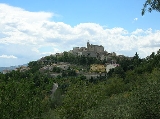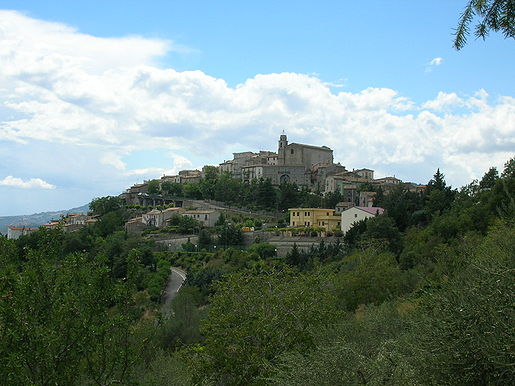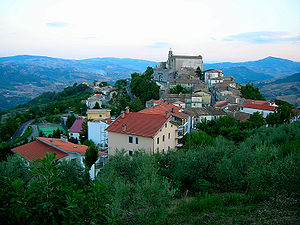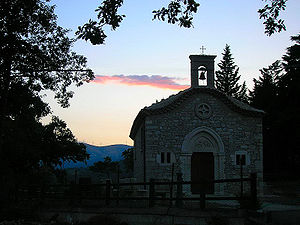
San Giovanni Lipioni
Encyclopedia
San Giovanni Lipioni is a small village
and comune
located at the southernmost tip of Province of Chieti
in the Abruzzo
region of Italy
, on a 545 m-high hill overlooking the river Trigno valley.

Starting from the 14th century, the village was under the influence of the Kingdom of Naples
through the Aragon
and the D'Avalos families, of Spanish origin, which held possessions in the nearby coastal town of Vasto
. The name Lipioni is thought indeed to be derived from the Spanish
los peones (unskilled labourers), referring to the predominant peasantry condition and sheep-rearing activity of the village's inhabitants.
Subsequently, until 1861 the village was under control of the Caracciolo families, always within the Kingdom of Naples territory.
Among the most important families of the village is nowadays the Rossi family, lawyers and medical doctors, owners of an important and ancient historical house. The building is now the focus of a judicial process between the heirs of the family.
The main produces are wine and extravirgin olive oil (renowned outside the region for its quality), along with wheat, corn, cherries, apples, walnuts, almonds, artichokes, tomatoes, and peppers.

, because of severe poverty and high unemployment, the village suffered a considerable emigration towards richer Northern Italy areas, especially in the town of Bologna
, where a sizeable community live nowadays. A small number also migrated to Belgium
, in the Charleroi
area to work in the local coal mines, and France by subsequently settling there.
From around 900 units in 1951, the population halved to 457 in 1982, and down to 371 in 1991, according to official ISTAT
statistics.
In 2001 the total population plummeted to 271 units and as of 2006, the stable residents are less than 250, of which those aged 65+ account for half of the total.
The nearest villages are Torrebruna
and Celenza sul Trigno
at a distance of 7 km each. The river Trigno
separating Abruzzo
from Molise
runs in the valley beneath the village 5.5 km far.
Things to see:
In early August, when the village comes alive with expatriates, night-time food feasts (called sagre) are common. One of these is the sagn' app'zat (literally "sagnas cut into pieces"), which are freshly made, slightly thick pasta layers sliced into rough 5x5 cm squares and eaten with a simple basil-and-tomato sauce, extra-virgin olive oil, and occasionally topped with lumps of ricotta cheese and/or bits of sliced spicy red chillies.
On every second Saturday of October, the food feast of the scurpelle — simple salted sourdough batons, 20-to-30 cm long, deep-fried in olive oil and eaten as such, accompanied by a glass of new red wine — is made to celebrate Santa Liberata.
 Another worth-mentioning specialty, also common to most villages in southern area of Chieti's province, is the ventricina, a usually round-shaped salami made of fresh pork finely chopped and mingled with bits of lard, ground dried red medium-spicy peppers, fennel seeds, and coarse salt, usually prepared during the colder winter days of January (after the first snow falls it is tradition to slaughter a pig), then hanged on the ceiling in a dry room and seasoned for usually 1+ months until ready to be sliced and served with freshly baked bread as an appetizer. At the same time, fresh pork sausages and pig liver sausages and several varieties of salami are prepared as well.
Another worth-mentioning specialty, also common to most villages in southern area of Chieti's province, is the ventricina, a usually round-shaped salami made of fresh pork finely chopped and mingled with bits of lard, ground dried red medium-spicy peppers, fennel seeds, and coarse salt, usually prepared during the colder winter days of January (after the first snow falls it is tradition to slaughter a pig), then hanged on the ceiling in a dry room and seasoned for usually 1+ months until ready to be sliced and served with freshly baked bread as an appetizer. At the same time, fresh pork sausages and pig liver sausages and several varieties of salami are prepared as well.
can be traced to the village, where his father was born and raised. His surname, along with Rossi and Monaco, is indeed quite common amongst the inhabitants.
Village
A village is a clustered human settlement or community, larger than a hamlet with the population ranging from a few hundred to a few thousand , Though often located in rural areas, the term urban village is also applied to certain urban neighbourhoods, such as the West Village in Manhattan, New...
and comune
Comune
In Italy, the comune is the basic administrative division, and may be properly approximated in casual speech by the English word township or municipality.-Importance and function:...
located at the southernmost tip of Province of Chieti
Chieti
Chieti is a city and comune in Central Italy, 200 km northeast of Rome. It is the capital of the Province of Chieti in the Abruzzo region...
in the Abruzzo
Abruzzo
Abruzzo is a region in Italy, its western border lying less than due east of Rome. Abruzzo borders the region of Marche to the north, Lazio to the west and south-west, Molise to the south-east, and the Adriatic Sea to the east...
region of Italy
Italy
Italy , officially the Italian Republic languages]] under the European Charter for Regional or Minority Languages. In each of these, Italy's official name is as follows:;;;;;;;;), is a unitary parliamentary republic in South-Central Europe. To the north it borders France, Switzerland, Austria and...
, on a 545 m-high hill overlooking the river Trigno valley.

History
The first settlement in the village presumably dates back to the pre-Roman times, when the area was under the control of the Samnites population. As an evidence of this is a III century B.C. bronze man's head discovered in the village countryside in 1847 and currently stored at the Bibliothèque Nationale de France.Starting from the 14th century, the village was under the influence of the Kingdom of Naples
Kingdom of Naples
The Kingdom of Naples, comprising the southern part of the Italian peninsula, was the remainder of the old Kingdom of Sicily after secession of the island of Sicily as a result of the Sicilian Vespers rebellion of 1282. Known to contemporaries as the Kingdom of Sicily, it is dubbed Kingdom of...
through the Aragon
Crown of Aragon
The Crown of Aragon Corona d'Aragón Corona d'Aragó Corona Aragonum controlling a large portion of the present-day eastern Spain and southeastern France, as well as some of the major islands and mainland possessions stretching across the Mediterranean as far as Greece...
and the D'Avalos families, of Spanish origin, which held possessions in the nearby coastal town of Vasto
Vasto
Vasto is a town and comune on the Adriatic coast of the Province of Chieti in southern Abruzzo, Italy. The population is now just over 40,000.-History:According to tradition, the town was founded by Diomedes, the Greek hero...
. The name Lipioni is thought indeed to be derived from the Spanish
Spanish language
Spanish , also known as Castilian , is a Romance language in the Ibero-Romance group that evolved from several languages and dialects in central-northern Iberia around the 9th century and gradually spread with the expansion of the Kingdom of Castile into central and southern Iberia during the...
los peones (unskilled labourers), referring to the predominant peasantry condition and sheep-rearing activity of the village's inhabitants.
Subsequently, until 1861 the village was under control of the Caracciolo families, always within the Kingdom of Naples territory.
Among the most important families of the village is nowadays the Rossi family, lawyers and medical doctors, owners of an important and ancient historical house. The building is now the focus of a judicial process between the heirs of the family.
Economy
The village essentially lives on agriculture like the neighbouring ones. The majority of the working population is employed in the sector, and production is geared towards local and family consumption.The main produces are wine and extravirgin olive oil (renowned outside the region for its quality), along with wheat, corn, cherries, apples, walnuts, almonds, artichokes, tomatoes, and peppers.

People
After the end of World War IIWorld War II
World War II, or the Second World War , was a global conflict lasting from 1939 to 1945, involving most of the world's nations—including all of the great powers—eventually forming two opposing military alliances: the Allies and the Axis...
, because of severe poverty and high unemployment, the village suffered a considerable emigration towards richer Northern Italy areas, especially in the town of Bologna
Bologna
Bologna is the capital city of Emilia-Romagna, in the Po Valley of Northern Italy. The city lies between the Po River and the Apennine Mountains, more specifically, between the Reno River and the Savena River. Bologna is a lively and cosmopolitan Italian college city, with spectacular history,...
, where a sizeable community live nowadays. A small number also migrated to Belgium
Belgium
Belgium , officially the Kingdom of Belgium, is a federal state in Western Europe. It is a founding member of the European Union and hosts the EU's headquarters, and those of several other major international organisations such as NATO.Belgium is also a member of, or affiliated to, many...
, in the Charleroi
Charleroi
Charleroi is a city and a municipality of Wallonia, located in the province of Hainaut, Belgium. , the total population of Charleroi was 201,593. The metropolitan area, including the outer commuter zone, covers an area of and had a total population of 522,522 as of 1 January 2008, ranking it as...
area to work in the local coal mines, and France by subsequently settling there.
From around 900 units in 1951, the population halved to 457 in 1982, and down to 371 in 1991, according to official ISTAT
Istituto Nazionale di Statistica
Istituto Nazionale di Statistica is the Italian national statistical institute.-History:Istat was created in 1926 to collect and organize essential data about the nation. Administering the census is one of its activities...
statistics.
In 2001 the total population plummeted to 271 units and as of 2006, the stable residents are less than 250, of which those aged 65+ account for half of the total.
Territory
The village lies at an altitude of 545 metres. The territory's highest peaks are Colle Vernone (717 m) overlooking the village, and the mountain Il Monte (693 m) facing it. Oaks and beeches are the predominant trees, along with firs and pine trees. Olive trees are also quite widespread over the territory, followed by fig, apple and cherry trees. Bush vegetation includes several type of wild berries and yellow brooms blooming in mid-springtime. Fauna features increasing numbers of boars and foxes, owls, and a few EU-protected species of kites (Milvus milvus and Milvus migrans) that nest in the woods of Il Monte and its vicinity.The nearest villages are Torrebruna
Torrebruna
Torrebruna is a comune and town in the Province of Chieti in the Abruzzo region of Italy...
and Celenza sul Trigno
Celenza sul Trigno
Celenza sul Trigno is a comune and town in the Province of Chieti in the Abruzzo region of Italy-External links:*...
at a distance of 7 km each. The river Trigno
Trigno
The Trigno is an 85 km Italian river. It originates in the Apennine Mountains, in the province of Isernia and flows into the Adriatic Sea near Vasto. It also forms the border between the regions Abruzzo and Molise.-See also:...
separating Abruzzo
Abruzzo
Abruzzo is a region in Italy, its western border lying less than due east of Rome. Abruzzo borders the region of Marche to the north, Lazio to the west and south-west, Molise to the south-east, and the Adriatic Sea to the east...
from Molise
Molise
Molise is a region of Southern Italy, the second smallest of the regions. It was formerly part of the region of Abruzzi e Molise and now a separate entity...
runs in the valley beneath the village 5.5 km far.
Things to see:
- The historical centre perched on the hilltop with its many old (some refurbished) hard-and-rough stone houses, the maze of tiny alleys, and the 17th-century church of Santa Maria delle Grazie, sitting at the top of a 200+ steps path starting from the pedestrianised main square Piazza Largo del Popolo.
- The historical house of Rossi family (Casa Madre), built in 1650, nowadays property of Rossi-Cianci family. Currently, the house is under restoration.
- The historical fountain, former owned by the local council, now property of Rossi-Cianci family, who bought it in 1960.
- The recently revamped small chapel of Santa Liberata, at the foot of Colle Vernone, with its adjoining small pinetree wood and picnic area, surrounded by pretty sights of the extensive olive tree fields and vineyards below, and the mountains around.
- Nearby, there's an imposing, tall, ancient oak called Quercia di Lozzi.
- The paved road from the village to Il Monte mountain makes for a scenic and easy 5 km walking nature trail, offering breathtaking views over the river TrignoTrignoThe Trigno is an 85 km Italian river. It originates in the Apennine Mountains, in the province of Isernia and flows into the Adriatic Sea near Vasto. It also forms the border between the regions Abruzzo and Molise.-See also:...
valley. On a clear day, the Adriatic SeaAdriatic SeaThe Adriatic Sea is a body of water separating the Italian Peninsula from the Balkan peninsula, and the system of the Apennine Mountains from that of the Dinaric Alps and adjacent ranges...
can be spotted in the distance (29 km NE), as well as the Maiella ridge (50 km NW), and the MateseMateseThe Matese is a chain of mountains in central Italy, central-southern Apennines.-Geography:...
mountains (47 km SW). A rest–picnic area with a spring water fountain known as Fonte del Trocco is found halfway before the road winds up through the thick oak wood up to the Il Monte top, when it unravels down through the fields. It then joins the main two-lane road SP202 leading to the village (2.5 km) across Colle Vernone, with more compelling sights of the hills and fields around.

Traditions and Specialties
On Labour Day (May, 1st) a colourful pageant is held throughout the village's high streets to celebrate lu Maje (The May), a circle-shaped wooden cane decked with small bunches of wild pink underbrush violets and other spring flowers and carried at the forefront of the pageant, which kicks off at the main church soon after the late morning mass. The flowers are then gifted to all families of the village during the door-to-door parade. A marching band plays along while food-and-drinks stalls are set out on the streets.In early August, when the village comes alive with expatriates, night-time food feasts (called sagre) are common. One of these is the sagn' app'zat (literally "sagnas cut into pieces"), which are freshly made, slightly thick pasta layers sliced into rough 5x5 cm squares and eaten with a simple basil-and-tomato sauce, extra-virgin olive oil, and occasionally topped with lumps of ricotta cheese and/or bits of sliced spicy red chillies.
On every second Saturday of October, the food feast of the scurpelle — simple salted sourdough batons, 20-to-30 cm long, deep-fried in olive oil and eaten as such, accompanied by a glass of new red wine — is made to celebrate Santa Liberata.

Trivia
The origins of the 2006 FIFA World Cup Italian scorer Fabio GrossoFabio Grosso
Fabio Grosso, Ufficiale OMRI is an Italian World Cup-winning footballer who currently plays for Serie A club Juventus. Grosso is primarily a left wingback, but can also play as left back. He is also a free kick, penalty kick and corner kick specialist...
can be traced to the village, where his father was born and raised. His surname, along with Rossi and Monaco, is indeed quite common amongst the inhabitants.

